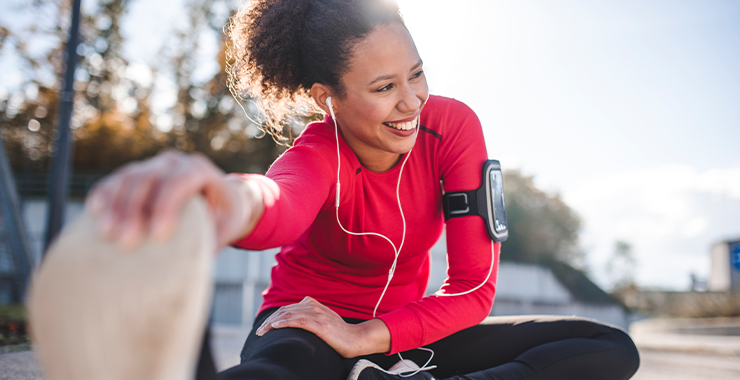Why Exercise Boosts Mood and Energy
Regular workouts can make a real difference in your energy level. Learn how to get the maximum benefits.
Regular workouts can make a real difference in your energy level and mood.
Feeling sluggish, tired, and sleepy? Just don’t have any energy to do what you need to do? Skip the extra cups of java and hours of sleeping in, and head to the gym.
According to Robert Gotlin, DO, a specialist in sports medicine at Lenox Hill Hospital and Mt. Sinai Hospital in New York City, the benefits of exercise for your energy level are twofold: Exercise boosts your body’s fitness and also your mood, both of which contribute to your overall health and well-being.
How Does Exercise Help Health and Well-Being?
Exercise boosts many areas of wellness because of:
- An increase in endorphin levels “Endorphins are our body’s natural hormones that get released when we are doing something that requires a burst of energy — they are the things that make us perform, make us move,” says Dr. Gotlin. “Exercise tends to increase those levels.” It’s the endorphin release that contributes to the feeling of euphoria commonly known as “runner’s high.”
- Better heart health Exercise boosts cardiovascular health, which allows you to have greater endurance throughout the day. When it’s easier to do your daily activities, you’ll have energy left over and not feel so tired when work is done. For overall cardiovascular health, the American Heart Association recommends at least 30 minutes of moderate-intensity aerobic activity at least five days a week. For lowering cholesterol and blood pressure, aim for 40 minutes of moderate- to vigorous-intensity aerobic activity three to four times per week.
- Improved sleep Exercise also allows you to get a better night’s rest; when you get high-quality sleep, you feel more refreshed during the day. A study published in April 2015 in the Journal of Sleep Research looked at people with insomnia who engaged in a minimum of 150 minutes of moderate-intensity physical activity spread over the course of a week. (this is the World Health Organization’s recommended level of physical activity for adults). Researchers found that this amount of physical activity was associated not only with a significant reduction in the severity of insomnia symptoms, but an elevation in mood as well.
- Sharper focus Mentally, we feel more energized and ready to tackle the world after a good workout because endorphins have boosted our physical energy level. According to a study of older adults published in April 2016 in Oxidative Medicine and Cellular Longevity, a program of 24 weeks of moderate aerobic exercise improved cognitive function, including concentration. While some researchers have speculated that higher intensity workouts might not have the same positive effect, a study published in February 2014 in the journal Perceptual and Motor Skills found that a session of high-intensity training improved cognitive function with respect to attention and short-term memory tasks.
Exercise Has Psychological and Mental Health Benefits, Too

“The psychological part of exercise has been shown to directly correlate with energy levels: You feel better and feel more energy,” Gotlin says.
A large body of research has consistently shown that regular exercise is associated with lower incidence of depression. There are several mechanisms and factors that are thought to be at work, and more research is needed to determine exactly why and how exercise helps with mood. But according to a review published in 2013 in the journal Neuropsychobiology, exercise is associated with the release of neurotransmitters and proteins called neurotrophic factors, which cause nerves to make new connections, possibly improving brain function and possibly playing a role in the reduction of depressive symptoms.
While physical activity itself provides a beneficial effect, the social aspect may also play a role in boosting mood. Heading to the park, the gym, or taking a group workout class gets you out of the house and interacting with others, which can ease isolation. And loneliness and social isolation are nothing to underestimate when it comes to mental health and well-being. A review of studies published in March 2015 in Perspectives on Psychological Health noted that both actual and perceived social isolation are associated with increased risk for early mortality.
Which Workouts Boost Energy the Most?

Any exercise or physical activity that gets the heart rate up and the blood flowing and releases endorphins is going to raise your energy level. Good cardiovascular exercises will strengthen your heart and give you more stamina.
Aerobic exercise, according to a review of studies published in March 2014 in the Journal of Science and Medicine in Sport, has been shown to be among the best when it comes to helping ease symptoms of depression.
But lower-intensity exercise, such as yoga, has also shown potential benefits when it comes to mood. Research suggests yoga may help reduce depression and anxiety, and a study published in September 2016 in the journal Depression and Anxiety found that six weeks of yoga, in addition to standard treatment for depression, reduced depressive symptoms. (10)
Physical activity, even if it’s not intense, routine exercise, was associated with lower levels of depression in a study published in March 2016 in the journal Frontiers in Psychology.
And a study published in September 2018 in the journal The Lancet Psychiatry, which analyzed data collected from 1.2 million adults age 18 and older in 2011, 2013, and 2015, found that individuals who reported exercising also reported having fewer days of poor mental health in the month preceding the survey, and that all types of exercise (including running, cycling, walking, gym exercise, winter sports, and others) were linked to a lower mental health burden overall.
Which are the best energy-boosting exercises? It’s really up to you and what you like to do. “It’s not going to work if you don’t like it. It’s got to be something that’s enjoyable that serves the aerobic goal,” says Gotlin. He also points out that it’s important to maintain a healthy diet, cut out the sweets, and increase protein to rebuild muscles to reap the most benefits from your workouts.
Pick something that you enjoy. Play a game of basketball, football, or tennis. Go jogging or walking with a friend, or go for a bike ride. Take some time for yourself and rock out to music or watch a favorite TV show while you step away the miles on an elliptical or stair-climbing machine at the gym. Go for a hike, or take your kids outside to the park and play with them.
You can also try aerobic classes — a kickboxing or other martial arts class, a spinning class, or any aerobic fitness class offered by a local gym.
The key is to find what you enjoy, stick with it, and reap the ongoing benefits of a regular workout routine.







